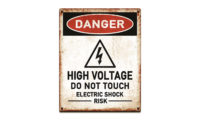Is your facility at risk due to inadequate electrical testing?

Credit: Getty Images
Ongoing monitoring and maintenance are crucial to all areas of equipment safety. However, some inspections are easier to overlook or make errors in than others. Industrial electrical testing is a common culprit.
High-powered industrial machinery introduces considerable electrical risks. Still, many facilities do not follow best practices when inspecting and maintaining machinery, leading to unnoticed and unmanaged hazards.
Risks of inadequate electrical testing
Like in all inspections, inadequate testing of electrical systems leads to complacency. Facilities believe they are safer than they are, opening the door to behavior they’d otherwise avoid if they knew something was wrong.
This oversight quickly becomes dangerous when managing high-voltage tools. There were 126 electricity-related workplace fatalities in 2020 alone. Such cases are also the most common form of death stemming from exposure to hazardous substances or environments. They’re among the top four causes of all workplace fatalities in the construction sector.
It’s also worth noting that 70% of all electrical fatalities happen in nonelectrical occupations. While nonexperts may be more likely to make mistakes around high-powered equipment, this trend casts a troubling light on inspectors and electricians. Many of these incidents may result from a failure of electrical experts to perform their duty in ensuring circuitry is safe for others to use.
Common mistakes in industrial electrical testing
Preventing such consequences starts with recognizing where errors typically arise. Businesses should watch for a few common mistakes when optimizing industrial electrical testing.
Not inspecting frequently enough
One of the easiest electrical inspection errors to make is not performing it frequently enough. OSHA holds that energy control procedures need inspection at least annually, but guidance over other powered equipment is less specific. The lack of firm regulatory guidance makes it all too easy to overlook testing for years on end.
Annual inspections are a good baseline for all electrical testing considerations but aren’t strictly necessary for every system. Electricians should test building circuitry at least every three years, and frequently used power tools should have a basic review before each use.
Not considering all factors
When businesses perform industrial electrical testing, many don’t consider all influencing factors. Ensuring proper voltage and gauging temperatures are among the most crucial considerations, so these are often the focus. However, less obvious steps like reviewing cable sizes and measuring insulation resistance may fly under the radar.
Employees often do not rush through inspections out of laziness or complacency. Rather, they forget about them or assume they may be less important due to high workloads and related stress. As understandable as the reasoning may be, such oversight is a dangerous error.
Not accounting for human error
Relatedly, some electrical inspectors may fail to account for errors in previous tests. Inspection records are necessary for any thorough examination, but taking them at face value is a mistake. Human error is far too common to assume a board schedule or previous test was entirely accurate.
Even professionals can make critical errors, as many missteps stem from overconfidence. Consider how more than 107,000 home improvement injuries involve manual tools, not powered alternatives. People make hazardous mistakes when working with things they’re more confident in. Consequently, businesses must perform specific tests each time instead of relying on the accuracy of an earlier report.
Industrial electrical testing best practices
In light of how easy it is to make mistakes in industrial electrical testing, organizations must practice greater care. Here are some best practices to embrace to prevent missteps and promote a higher standard of safety.
Review applicable codes
The first step in better electrical testing is ensuring organizations understand the standards they must meet. Requirements vary widely depending on the type of machinery, industry and local government regulations, so businesses must perform thorough research ahead of time.
NFPA 70 is a reliable benchmark for general electrical guidelines, so inspectors can start with this code. Other potential applicable standards include NFPA 70E, NFPA 78 and ANSI C2. It’s also important to consider state and city laws that may offer more specific guidance than federal or industry regulations.
Use the right tools for the job
Next, electrical inspectors must use appropriate equipment for each kind of inspection. Regulatory texts often outline the types of tools businesses should use for each test, but it’s a good idea to look beyond such minimums.
Testers can gain a lot from using more sophisticated measuring devices than laws require. Igniter circuit testers are a great example, as their current is 1,000 times lower than conventional ohmmeters, offering far higher precision. Regulatory texts often outline the types of tools businesses should use for each test, but looking beyond such minimums is a good idea.
Test everything
Given how easy it is to overlook some considerations, industrial electrical testing should include specific tests for every influencing factor. That means inspecting every component within a circuit along all lines, including voltage, impedance, temperatures and environmental hazards.
Some tools can perform multiple tests simultaneously, making thorough inspection less time-consuming. Even in cases requiring several pieces of equipment, inspectors must not rely on the guidance of previous records. This documentation should serve as proof of regular testing, not a source of absolute truth or indication of a circuit’s current condition.
Emphasize employee training
As in many safety processes, electrical inspections also require extensive employee training. Formal certification is not mandatory in all states, but most licensing programs ensure compliance with codes like NFPA 70, so they’re a good idea. Businesses can encourage workers to achieve such standards by providing complimentary access to these courses.
Regardless of whether an organization requires certification, it should test employees’ knowledge at least annually. Regular retraining will prevent complacency and ensure inspectors keep best practices and important steps at the top of their minds.
Capitalize on automation
Automating as much of the industrial electrical testing process as possible is also often beneficial. Human errors are too common to rely on manual testing, even with expert employees. Automation will also help organizations overcome the ongoing electrician shortage without sacrificing safety.
Smart meters and other Internet of Things (IoT) devices can monitor voltage, ohms and other electrical factors in real time. They then alert stakeholders as soon as any of these measurements exceed acceptable parameters. Consequently, inspections become faster and more reliable.
Getting electrical testing right is crucial
Extensive testing is important in many equipment considerations. However, the stakes are often higher in electrical systems than in other use cases.
Circuitry requires attention to multiple easy-to-miss considerations and can have dangerous consequences if testing is inadequate. That may be intimidating, but businesses that follow these best practices can ensure their employees’ safety.
Looking for a reprint of this article?
From high-res PDFs to custom plaques, order your copy today!







